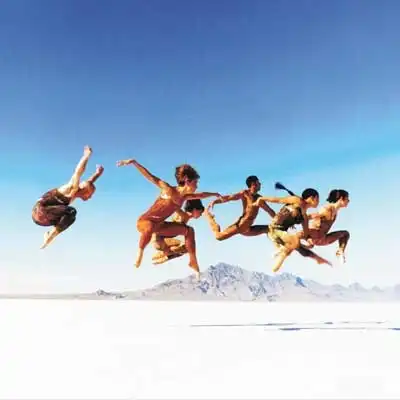Breaking the Ballet: Ririe-Woodbury
Community
Ririe-Woodbury was founded in 1964 by namesakes Shirley Ririe and Joan Woodbury, and has tirelessly built a reputation as one of the most respected modern dance companies in America. Their dedication to producing new works, touring, promoting dance through their Move-It and POPS education programs, and their close involvement with choreographer Alwin Nikolais have garnered praise far and wide, including five-star reviews in the New York and Los Angeles Times and invitations to perform at some of the world’s most prestigious dance festivals.
The company’s relationship with choreographer Alwin Nikolais is arguably what they are most famous for; in fact, it seems that any conversation about Ririe-Woodbury inevitably leads to a mention of his name. Joan Woodbury first met Nikolais in 1947 at Dresden University when she was put in his class after failing to place into the advanced courses. “It was the best thing that ever happened to me,” she says. “He said things about dance that I had thought but could never put into words.” Nikolais soon became her mentor and the two continued to collaborate with and inspire each other for decades.
This year, Ririe-Woodbury’s dedication to both the work of Nikolais and children’s dance education are coming together in The Crystal and the Sphere, one of Nikolais’ pieces from the early fifties commissioned by the Kennedy Center. “We do a work for children every year,” says Joan. “We feel strongly that if you don’t catch kids when they’re young they won’t be interested in the artform when they’re older.”
In choosing this piece by Nikolais, however, they are deviating from their traditional children’s works, as The Crystal and the Sphere is decidedly more avant-garde, done entirely in black light, with no immediately recognizable structure. “Usually we have a narration to keep the kids involved, but this one is just dance. There’s a narrative, but you have to find it.” The dances are fanciful, featuring waddle birds, mermaids, sharks, and something called an “infant sun,” but it is up to the kids (and adults) to find the connection between these disparate creations.
Joan is optimistic, however, that the children will be able to find the narrative; it is the adults and the folks in their mid-20s that she is most worried about. Her company’s motto is “dance is for everyone,” which carries a kind of unfortunate irony when attached to an artform as polarizing as modern dance. “My feeling of ‘what is dance’ is very broad,” she says. “If you do a gesture which is not utilitarian, it’s not picking up a cup or scratching your head, a gesture you do for the pure joy of doing it, you’re dancing.”
Yet, even with this populist attitude, modern dance remains on the fringes, and is seen by a large segment of the population as being too esoteric, too confusing, or even an outright scam. Joan sees this as symptomatic of two things; first of all, “I think one of the difficulties people have with modern dance is that they’ve seen a lot of bad dances.” Secondly, she says, “I think adults are afraid to enjoy it, afraid to rely on their own judgment. It’s like going to buy a dress that you may really like, but you still turn to someone and say, ‘what do you think?”
This inability (or unwillingness) of adults to make up their own minds does not bode well for an artform that requires active rather than passive viewing. Most people don’t want to find the narrative themselves; they would rather have it served to them on a plate in the privacy of their own homes. Joan recognizes this, and can only hope for the best. “We know sometimes we’re dancing to the choir… sometimes I feel like going and pulling someone in from the street and saying, ‘What do you think about this?'”
Speaking directly to me, Joan says, “Mostly you’re not a physical generation. It’s so much easier to rent a movie and go home with it and go to bed than it is to get dressed up and go out and try to park… I’m not interested in getting (my generation) to attend live theater; it’s your generation that’s going to carry it forward.”
So it comes back to the old adage “children are our future.” But tired though that may sound, Ririe-Woodbury hopes to breathe some new life into that cliché by producing consistently thoughtful and challenging works for people of all ages, in hopes that people will put off seeing that new Will Smith or Pixar movie for another night and try something that’s actually outside their comfort zone for a change.
For more information on Ririe-Woodbury, including their production of Alwin Nikolais’ The Crystal and the Sphere, check out www.ririewoodbury.com.

